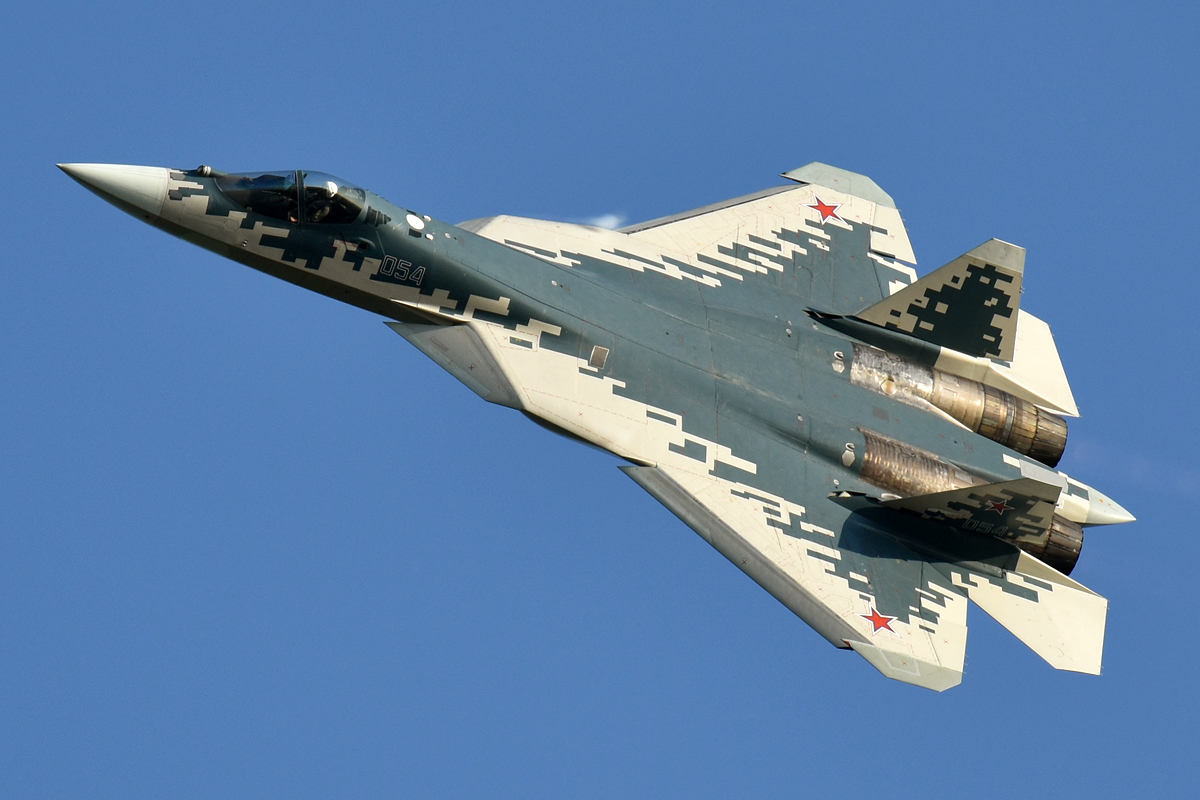The Sukhoi Su-57 is a twin-engine stealth multirole fighter aircraft developed by Sukhoi. It is the product of the PAK FA (Russian: ПАК ФА, prospective aeronautical complex of front-line aviation) programme, which was initiated in 1999 as a more modern and affordable alternative to the MFI (Mikoyan Project 1.44/1.42). Sukhoi's internal designation for the aircraft is T-50. The Su-57 is the first aircraft in Russian military service designed with stealth technology and is intended to be the basis for a family of stealth combat aircraft.
A multirole fighter capable of aerial combat as well as ground and maritime strike, the Su-57 incorporates stealth, supermaneuverability, supercruise, integrated avionics and large payload capacity. The aircraft is expected to succeed the MiG-29 and Su-27 in the Russian military service and has also been marketed for export.
After repeated delays, the first Su-57 entered service with the Russian Aerospace Forces (VKS) in December 2020.
Origins
In 1979, the Soviet Union outlined a need for next-generation fighter aircraft intended to enter service in the 1990s. The programme became the I-90 (Russian: И-90, short for: Истребитель 1990–х годов, lit. 'Fighter of the 1990s') and required the fighter to be "multifunctional" (i.e. multirole) by having substantial ground attack capabilities, and would eventually replace the MiG-29 and Su-27 in frontline tactical aviation service.
Though not a participant in the MFI, Sukhoi started its own programme in 1983 to develop technologies for a next-generation fighter, eventually resulting in the forward-swept wing S-32 experimental aircraft, later redesignated S-37 and then Su-47.
Due to a lack of funds after the dissolution of the Soviet Union, the MFI was repeatedly delayed and the first flight of the MiG 1.44/1.42 prototype did not occur until 2000, nine years behind schedule.
Because of Russia's financial difficulties, the programme aimed to rein in costs by producing a single multirole fifth-generation fighter that would replace both the Su-27 and the MiG-29. Further cost-saving measures include an intended size in between that of the Su-27 and the MiG-29 and normal takeoff weight considerably smaller than the MiG MFI's 28.6 tonnes (63,000 lb) and the Su-47's 26.8 tonnes (59,000 lb).
In April 2002, the Ministry of Defence selected Sukhoi over Mikoyan as the winner of the PAK FA competition and the lead design bureau of the new aircraft. In addition to the merits of the proposal, Sukhoi's experience in the 1990s was taken into account, with the successful development of various Su-27 derivatives and numerous exports ensuring its financial stability.
Design
The Su-57 is a fifth-generation multirole fighter aircraft and the first operational stealth aircraft for the Russian armed forces. In addition to stealth, the fighter emphasizes supermaneuverability in all aircraft axes, capacious internal payload bays for multirole versatility, and advanced sensor systems such as active phased-array radar as well as the integration of these systems to achieve high levels of automation
The aircraft has a wide blended wing body fuselage with two widely spaced engines and has all-moving horizontal and vertical stabilisers, with the vertical stabilisers canted for stealth; the trapezoid wings have leading edge flaps, ailerons, and flaperons. The aircraft incorporates thrust vectoring and large leading edge root extensions that shift the aerodynamic center forward, increasing static instability and maneuverability.
Designed from the outset as a multirole aircraft, the Su-57 has substantial internal payload capacity that allows the carriage of multiple large air-to-surface ordnance. Weapons are housed in two tandem main weapons bays in the large ventral volume between the widely spaced engine nacelles and smaller side bays with bulged triangular-section fairings near the wing root.
The first aircraft in Russian military service to emphasize stealth, the Su-57 employs a variety of methods to reduce its radar signature. Similar to other stealth fighters such as the F-22, the aircraft aligns the planform edges to reduce its radar cross-section (RCS); the leading and trailing edges of the wings and control surfaces and the serrated edges of skin panels are carefully angled to reduce the number of directions the radar waves can be reflected. Weapons are carried internally in weapons bays within the airframe and antennas are recessed from the surface of the skin to preserve the aircraft's stealthy shape, while radar absorbent material (RAM) coatings absorb radar emissions and reduce the reflection back to the source.
As with other stealth fighters, the Su-57's low observability measures are chiefly effective against super-high-frequency (between 3 and 30 GHz) radars, usually found on other aircraft. The effects of Rayleigh scattering and resonance mean that low-frequency radars, employed by weather radars and early-warning radars are more likely to detect the Su-57 due to its size.
Megathreads and spaces to hang out:
- 📀 Come listen to music and Watch movies with your fellow Hexbears nerd, in Cy.tube
- 🔥 Read and talk about a current topics in the News Megathread
- ⚔ Come talk in the New Weekly PoC thread
- ✨ Talk with fellow Trans comrades in the New Weekly Trans thread
- 👊 Share your gains and goals with your comrades in the New Weekly Improvement thread
- 🧡 Disabled comm megathread
reminders:
- 💚 You nerds can join specific comms to see posts about all sorts of topics
- 💙 Hexbear’s algorithm prioritizes comments over upbears
- 💜 Sorting by new you nerd
- 🌈 If you ever want to make your own megathread, you can reserve a spot here nerd
- 🐶 Join the unofficial Hexbear-adjacent Mastodon instance toots.matapacos.dog
Links To Resources (Aid and Theory):
Aid:
Theory:

Settlers or Caliban and the Witch, which one should I read next? Definitely need to purge the inner and definitely need to purge any misogyny
and definitely need to purge any misogyny  that remain in my headspace. Gonna read both regardless, but now that I have more time due to logging out of Lemmy.ml I want to channel that into killing my inner lib, all facets of him, that remain.
that remain in my headspace. Gonna read both regardless, but now that I have more time due to logging out of Lemmy.ml I want to channel that into killing my inner lib, all facets of him, that remain.
I've heard you need to take Caliban with caution as many of it's assertions are disputed by other credible historians and there's a good argument to be made that the interpretation of the contemporary culture of the period was massaged to better fit the argument. I'd suggest reading it like Zinn's People's History of the United States, going in knowing that what you're reading is a history written to support a perspective and argument. The author isn't necessarily wrong or lying or anything, but they are making their argument from a clear ideological perspective that may put them in disagreement with other scholars of the era. History is very much a process of interpretation, rather than simply dealing with facts. Every historian has biases (and historians who tell you they don't have biases should not be trusted) and it's good to have an understanding of what their biases and goals are when you are going in to the book.
I want to stress that having biases is not a bad thing! For instance, you may agree with the historian's argument, but knowing that they hold a certain bias can allow you to spot weaknesses in their argument. You can then apply your own knowledge to shore up those weakspots by bringing in supporting evidence and arguments from another perspective. Working together two historians can thus produce a stronger argument that benefits from each of their particular focuses and strengths.
Trying to eliminate bias is a fools errand that mostly just leads to self-deception. Instead, you can make your work stronger by trying to understand your own biases and the biases of others allowing you to directly respond to criticism instead of being blindsided by things you can't see.
Gotcha, will keep that in mind. I know that overall it's respected here, however.
Haven’t read caliban but settlers is to me pretty essential reading especially if you’re American. I think wretched of the earth is also good to read alongside settlers
Yep, plan on reading all of those eventually.
Focusing on your ideas? How idealist of you! How lib of you! (/s, bad joke)
Also good joke